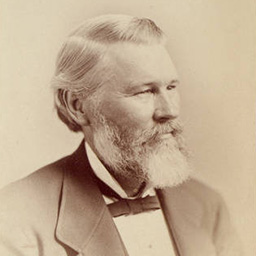
Photo info ...
Credit: Indiana Historical SocietyView Source
(Sept. 12, 1818-Feb. 26, 1903). Richard J. Gatling, born in North Carolina, later moved to St. Louis, Missouri, where, in 1844, he invented and received a patent for a successful seed planter. In 1847, he enrolled as a student in the Indiana Medical College, the Medical Department of La Porte University in La Porte, Indiana. Later he took classes in the Ohio Medical College in Cincinnati.

By the early 1850s, he resided in Indianapolis and was active in business and real-estate speculation. He continued to invent products, mainly agricultural implements. In 1860 alone he received five patents. In 1854 he married Jemima Sanders, whose sister was married to former Indiana governor David Wallace, father of , soldier in the Mexican War and Civil War, and author of the popular novel Ben Hur.
In 1861, at the beginning of the , Gatling developed the idea of a weapon with six revolving, rifled barrels that were turned and fired by a hand crank. The device could fire up to 200 bullets per minute. In the following months, he made refinements and demonstrated his “Gatling Gun” to local notables and military officers, including Indiana governor , who became an enthusiastic booster. The governor contacted Washington, D.C., officials to urge adoption of the weapon for use by Union military and naval forces. Gatling secured a U.S. patent for his invention in November 1862.
Despite successful demonstrations, Gatling’s gun was rejected by the chief of ordnance of the U.S. Army, Gen. James W. Ripley, who, while an efficient administrator, was a hidebound conservative about new technologies. Only a handful of Gatling Guns were produced during the war, and those saw little or no service. The story that Gatling’s invention was used during the New York City draft riots in July 1863 by publisher Henry Raymond is a baseless legend. In 1866, after the end of the war and Ripley’s replacement, the U.S Army ordered 100 Gatling Guns.
In June 1864, during the Civil War, the head of army intelligence in Indianapolis, Brig. Gen. Henry B. Carrington, received reports from his detectives that Gatling attended secret meetings of the Sons of Liberty, an organization that aimed to subvert the Union war effort and aid the Confederate rebellion. Carrington wrote to the Ordnance Bureau of the War Department in Washington, D.C., to check on the army’s relationship to Gatling. The inventor’s presence in secret Sons of Liberty meetings arose in testimony before the military commission that tried Indiana conspirators that autumn in the Indianapolis . Gatling published a statement in Indianapolis newspapers to defend himself.
After the war, Gatling moved to Hartford, Connecticut, where his gun was manufactured after he sold his patent. He perfected his Gatling Gun and continued to invent other devices.

Help improve this entry
Contribute information, offer corrections, suggest images.
You can also recommend new entries related to this topic.